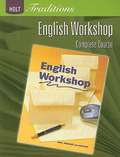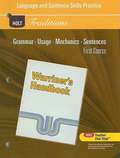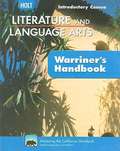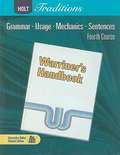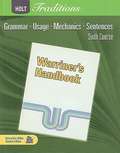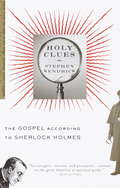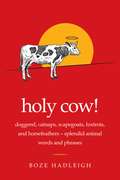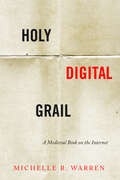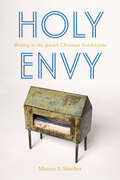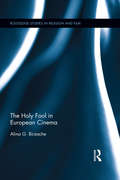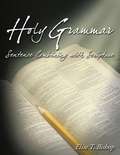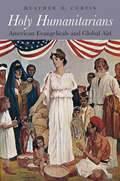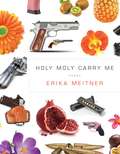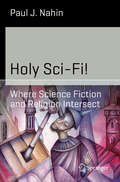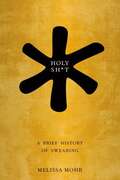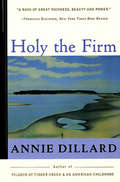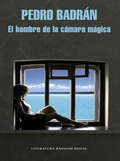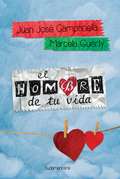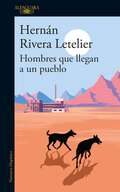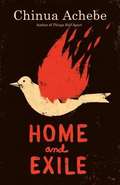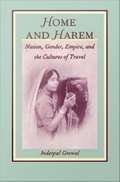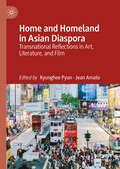- Table View
- List View
Holt Science & Technology (Grade 7, Texas Edition)
by Holt Rinehart WinstonScience textbook for Texas 7th graders.
Holt Traditions, Complete Course, English Workshop
by Rinehart Winston Staff HoltNIMAC-sourced textbook
Holt Traditions, Language and Sentence Skills Practice: Fourth Course, Grade 10 (Holt Traditions Warriner's Handbook)
by Holt Rinehart HoltNIMAC-sourced textbook
Holt Traditions, Language and Sentence Skills Practice, First Course
by Rinehart And Winston Staff HoltNIMAC-sourced textbook
Holt Traditions, Warriner's Handbook: Introductory Course
by John E. WarrinerNIMAC-sourced textbook
Holy Clues: The Gospel According to Sherlock Holmes
by Stephen KendrickIf God is the greatest mystery of them all, then why not, in pursuit of God, consult the greatest detective of them all? In this imaginative and surprisingly profound book, Stephen Kendrick reveals Sherlock Holmes as spiritual guide. Drawing on the teachings of Christianity, Buddhism, and Judaism--as well as a host of thinkers as varied as Albert Einstein, Gandhi, and Vincent van Gogh--Kendrick explores the stories of Sherlock Holmes and finds remarkably prescient religious insights. He shows us the link between careful observation of clues and the Buddhist concept of "Bare Attention. " He illuminates the parallel between the great sleuth's pursuit of justice and God's actions on the scene of the first murder, when Cain slew Abel. And in the detective's open, engaged mind, Kendrick finds a model for uniting the principles of science with a sincere spiritual quest. The result is a book of inspiration for the modern, skeptical searcher--and an entertaining work that sheds new light on the methods of the world's greatest detective.
Holy Cow!: Doggerel, Catnaps, Scapegoats, Foxtrots, and Horse Feathers?Splendid Animal Words and Phrases
by Boze HadleighWe love animals but insult humans by calling them everything from weasels or pigs to sheep, mice, chickens, sharks, snakes, and bird-brains. Animal epithets, words, and phrases are so widespread we often take them for granted or remain ignorant of the fascinating stories and facts behind them. Spanning the entire animal kingdom, Holy Cow! explains: Why hot dogs are named after canines. Why people talk turkey or go cold turkey. Why curiosity killed the cat, although dogs are more curious about us. Why letting the cat out of the bag originally referred to a duped shopper. What a horse of another color is, what horsefeathers politely alludes to, why a mule is a lady’s slipper, and what horseradish has to do with horses. Why the combination of humans and cows probably led to capitalism--its name from Latin for head, as in heads of cows. Why holy cow and sacred cow have almost opposite meanings. Whether people actually chewed the fat or ate crow (and why it’s a crowbar). How a hog became a motorcycle and a chick a young woman. What happens to freeze the balls off a brass monkey. What buck has to do with being naked. Why the birds and the bees. Why a piggy bank and why one feeds the kitty. What lame ducks have to do with U. S. presidents. How red herring came about via activists opposed to fox hunting. Where snake oil, popular in the 1800s and rich in Omega-3 fatty acids, came from. That the proverbial fly in the ointment goes back to the Bible’s Ecclesiastes (10:1). How Swiss watchmakers created teensy-weensy coaches for fleas to pull in flea circuses. And much--much!--more. Don't be a lame duck and get this book!
Holy Digital Grail: A Medieval Book on the Internet (Stanford Text Technologies)
by Michelle R. WarrenMedieval books that survive today have been through a lot: singed by fire, mottled by mold, eaten by insects, annotated by readers, cut into fragments, or damaged through well-intentioned preservation efforts. In this book, Michelle Warren tells the story of one such manuscript—an Arthurian romance with textual origins in twelfth-century England now diffused across the twenty-first century internet. This trajectory has been propelled by a succession of technologies—from paper manufacture to printing to computers. Together, they have made literary history itself a cultural technology indebted to colonial capitalism. Bringing to bear media theory, medieval literary studies, and book history, Warren shows how digital infrastructures change texts and books, even very old ones. In the process, she uncovers a practice of "tech medievalism" that weaves through the history of computing since the mid-twentieth century; metaphors indebted to King Arthur and the Holy Grail are integral to some of the technologies that now sustain medieval books on the internet. This infrastructural approach to book history illuminates how the meaning of literature is made by many people besides canonical authors: translators, scribes, patrons, readers, collectors, librarians, cataloguers, editors, photographers, software programmers, and many more. Situated at the intersections of the digital humanities, library sciences, literary history, and book history, Holy Digital Grail offers new ways to conceptualize authorship, canon formation, and the definition of a "book."
Holy Envy: Writing in the Jewish Christian Borderzone
by Maeera ShreiberWhat is between us and the Christians is a deep dark affair which will go for another hundred generations . . .” (Amos Oz, Judas)Among the great social shifts of the post–World War II era is the unlikely sea-change in Jewish Christian relations. We read each other’s scriptures and openly discuss differences as well as similarities. Yet many such encounters have become rote and predictable. Powerful emotions stirred up by these conversations are often dismissed or ignored. Demonstrating how such emotions as shame, envy, and desire can inform these encounters, Holy Envy: Writing in the Jewish Christian Borderzone charts a new way of thinking about interreligious relations. Moreover, by focusing on modern and contemporary writers (novelists and poets) who traffic in the volatile space between Judaism and Christianity, the book calls attention to the creative implications of these intense encounters.While recognizing a long-overdue need to address a fundamentally Christian narrative underwriting twentieth century American verse, Holy Envy does more than represent Christianity as an aesthetically coercive force, or as an adversarial other. For the book also suggests how literature can excavate an alternative interreligious space, at once risky and generative. In bringing together recent accounts of Jewish Christian relations, affect theory, and poetics, Holy Envy offers new ways into difficult and urgent, conversations about interreligious encounters.Holy Envy is sure to engage readers who are interested in literature, religion, and, above all, interfaith dialogue.
The Holy Fool in European Cinema (Routledge Studies in Religion and Film)
by Alina G. BirzacheThis monograph explores the way that the profile and the critical functions of the holy fool have developed in European cinema, allowing this traditional figure to capture the imagination of new generations in an age of religious pluralism and secularization. Alina Birzache traces the cultural origins of the figure of the holy fool across a variety of European traditions. In so doing, she examines the critical functions of the holy fool as well as how filmmakers have used the figure to respond to and critique aspects of the modern world. Using a comparative approach, this study for the first time offers a comprehensive explanation of the enduring appeal of this protean and fascinating cinematic character. Birzache examines the trope of holy foolishness in Soviet and post-Soviet cinema, French cinema, and Danish cinema, corresponding broadly to and permitting analysis of the three main orientations in European Christianity: Orthodox, Catholic, and Protestant. This study will be of keen interest to scholars of religion and film, European cinema, and comparative religion.
Holy Grammar: Sentence Combining with Scripture
by Elise BishopA workbook like no other, Holy Grammar teaches basic grammar skills using examples and exercises only from Scripture. Students apply sentence combining techniques to over 200 Bible verses to improve the complexity, correctness, and variety of sentences in their own writing. Designed for use in a composition class, Holy Grammar was written by a secondary and college composition and grammar instructor with over 35 years of experience in the classroom. In a challenging way that relies more on intrinsic knowledge of language than memorization of rules, the exercises provide students with the practice they need to produce (and correctly punctuate) a variety of sentence types. The teaching tips included demonstrate flexible methods for teachers who want to incorporate the lessons into their classes. With the Bible itself serving as the answer key, students have the ability to check their own work. A grammar review section examines parts of speech, clauses and phrases, and basic sentence types and patterns. The skills presented in this workbook lay the foundation for more advanced grammar study.
Holy Humanitarians: American Evangelicals and Global Aid
by Heather D. CurtisOn May 10, 1900, an enthusiastic Brooklyn crowd bid farewell to the Quito. The ship sailed for famine-stricken Bombay, carrying both tangible relief—thousands of tons of corn and seeds—and “a tender message of love and sympathy from God’s children on this side of the globe to those on the other.” The Quito may never have gotten under way without support from the era’s most influential religious newspaper, the Christian Herald, which urged its American readers to alleviate poverty and suffering abroad and at home. In Holy Humanitarians, Heather D. Curtis argues that evangelical media campaigns transformed how Americans responded to domestic crises and foreign disasters during a pivotal period for the nation. Through graphic reporting and the emerging medium of photography, evangelical publishers fostered a tremendously popular movement of faith-based aid that rivaled the achievements of competing agencies like the American Red Cross. By maintaining that the United States was divinely ordained to help the world’s oppressed and needy, the Christian Herald linked humanitarian assistance with American nationalism at a time when the country was stepping onto the global stage. Social reform, missionary activity, disaster relief, and economic and military expansion could all be understood as integral features of Christian charity. Drawing on rigorous archival research, Curtis lays bare the theological motivations, social forces, cultural assumptions, business calculations, and political dynamics that shaped America’s ambivalent embrace of evangelical philanthropy. In the process she uncovers the seeds of today’s heated debates over the politics of poverty relief and international aid.
Holy Moly Carry Me (American Poets Continuum #166)
by Erika MeitnerWinner of the 2018 National Jewish Book Award for Poetry Erika Meitner’s fifth collection of poetry plumbs human resilience and grit in the face of disaster, loss, and uncertainty. These narrative poems take readers into the heart of southern Appalachia—its highways and strip malls and gun culture, its fragility and danger—as the speaker wrestles with what it means to be the only Jewish family in an Evangelical neighborhood and the anxieties of raising one white son and one black son amidst racial tensions and school lockdown drills. With a firm hand on the pulse of the uncertainty at the heart of 21st century America and a refusal to settle for easy answers, Meitner’s poems embrace life in an increasingly fractured society and never stop asking what it means to love our neighbor as ourselves.
Holy Sci-Fi!
by Paul J. NahinCan a computer have a soul? Are religion and science mutually exclusive? Is there really such a thing as free will? If you could time travel to visit Jesus, would you (and should you)? For hundreds of years, philosophers, scientists and science fiction writers have pondered these questions and many more. In Holy Sci-Fi!, popular writer Paul Nahin explores the fertile and sometimes uneasy relationship between science fiction and religion. With a scope spanning the history of religion, philosophy and literature, Nahin follows religious themes in science fiction from Feynman to Foucault and from Asimov to Aristotle. An intriguing journey through popular and well-loved books and stories, Holy Sci-Fi! shows how sci-fi has informed humanity's attitudes towards our faiths, our future and ourselves.
Holy Sh*t: A Brief History of Swearing
by Melissa MohrDetermining what is obscene is a timeless preoccupation, nearly as timeless as the search for words that adequately express a relationship with the divine. As Melissa Mohr shows in this imaginative and illuminating tour through linguistic history, those preoccupations are not separate. "Swearing" is what we do when we forge a bond with a higher authority, as when we tell the truth and nothing but the truth; it is also what we do to break that bond. In both cases, certain words are endowed with the power to shock or to awe. Obscenities tend toward the earthy and generally remind us that we have bodies. Oaths are lifted to heaven and serve to remind us that we have souls. Holy Sh*t brilliantly and entertainingly investigates these two kinds of swearing--obscenities and oaths--from ancient Rome and the Bible to the present, uncovering the history of sacred and profane language in English through the ages. It is a journey with a number of surprises. Obscenities in ancient Rome were remarkably similar to our own; George Carlin would have felt completely at home. With the rise of the Church came a new sense of how language should be used, or not--and the difference was often a matter of life and death. Holy Sh*t tracks the advancement of civility and corresponding censorship of language in the eighteenth century; considers the rise of racial slurs after World War II; examines the physiological effects of swearing (increased heart rate and greater pain tolerance); and answers a question that preoccupies the FCC, the U.S. Senate, and anyone who has lately visited a junior high school: are we swearing more now than people did in the past? A gem of lexicography and cultural history, Holy Sh*t is a serious exploration of linguistic totem and taboo. It charts the way swearing has changed over the centuries, and considers the cultural concerns that gave way to those changes. By looking at the words that have expressed our deepest emotions, high and low, Holy Sh*t reveals the shifting relationship between the divine and the dirty. MELISSA MOHR has recently been dividing her time between writing this book about swearing, and hiding it from her kids. She received a Ph.D. in English literature from Stanford University, specializing in Medieval and Renaissance literature. She lives in Somerville, Massachusetts.
Holy the Firm
by Annie DillardIn 1975 Annie Dillard took up residence on an island in Puget Sound in a wooded room furnished with "one enormous window, one cat, one spider and one person." For the next two years she asked herself questions about time, reality, sacrifice death, and the will of God. In Holy the Firm she writes about a moth consumed in a candle flame, about a seven-year-old girl burned in an airplane accident, about a baptism on a cold beach. But behind the moving curtain of what she calls "the hard things -- rock mountain and salt sea," she sees, sometimes far off and sometimes as close by as a veil or air, the power play of holy fire. This is a profound book about the natural world -- both its beauty and its cruelty -- the Pulitzer Prize-winning Dillard knows so well.
Homage to Robert Penn Warren: A Collection of Critical Essays
by Frank GrazianoHighly supportive essays.
El hombre de la cámara mágica
by Pedro José BadranUna novela de Pedro Badrán. Con su cámara de instantáneas, Tony Lafont se proponehacer un inventario exhaustivo de un hotel de Cartagena. Tiene lamisteriosa convicción de que cada uno de los objetos que lo pueblan, sushabitaciones, las sombras bamboleantes sobre sus paredessalitrosas, así como sus huéspedes, presentes y pasados,son el reflejo del universo. La novela es la historia de ambos, delhotel y del fotógrafo, de la leyenda que gestaron, pero es sobre todo unálbum fascinante de una época y unos personajes llenos de contrastes,lúcidos, ingenuos, tiernos, melancólicos, divertidos.«En esta novela, el asunto no es únicamente el rastreode un fotógrafo legendario y sus huellas en un hospedaje caribeño, sinoel registro de unas vidas que pasan lentamente, sin fecha devencimiento, a la espera de la hora de entregar la última habitación."Como siempre, es notable la prosa de Pedro Badrán, su grancapacidad para crear atmósferas».Juan Manuel Roca«Nadie como Pedro Badrán para captar el alma de sus personajes, pararecrear la sensualidad, la luz y la sonoridad del Caribe con un lenguajesencillo y preciso que nunca aburre al lector».Peter Shultze-Kraft«Badrán es dueño de un estilo en el que la precisión de lenguaje y ellirismo casi sensualista armonizan a la perfección».Diario El País, de España«Nunca he leído un cuento de Pedro Badrán sin una intensa sensación degratitud. La inteligencia, el humor desaforado, el oído impecablepara las formas de hablar de la gente: ahí está todo. Su obra enriquecela tradición de un género que en Colombia no carece deriqueza».Juan Gabriel Vásquez«Poderoso relato sobre la intimidad, los ritos de paso y eldesconcierto, parte de una metáfora aún mayor, puesto que tras las vidasprivadas podemos leer el derrumbe de un país yde una época».Diario Hoy, de España, sobre El día de la mudanza«Estamos en la tradición de la escuela policíaca norteamericana,retomada con acierto por muchos autores latinoamericanos. Nohay duda: la originalidad más interesante es la que vuelve a losorígenes».Revista Semana, sobre Un cadáver en la mesa es mala
El hombre de tu vida
by Juan José Campanella Marcela GuertySe trata de la novelización de la comedia televisiva del mismo nombre,escrita y dirigida por Juan José Campanella y protagonizada porGuillermo Francella, Luis Brandoni y Mercedes Morán que emitió Telefé en2011/2012 y que emitirá HBO para toda Latinoamérica en 2013. Hugo, honesto, trabajador y viudo, cría solo a su único hijo.Desocupado, su prima Gloria le hace una oferta laboral disparatada queno puede rechazar. La necesidad, dicen, tiene cara de hereje. Así setransforma en el candidato comodín de una agencia de citas. Para cadaclienta, Hugo intenta ser el hombre ideal. Lo importante es que cada unaquede tan conforme como para pagar la cuenta y tan desencantada comopara no seguir la relación. Sin poder evitarlo, Hugo se involucraráintensamente con los conflictos emocionales de las mujeres a las queconoce.El hombre de tu vida, éxito de Telefe surgido de la imaginación de JuanJosé Campanella y Marcela Guerty, nos muestra cómo un hombre común ycorriente le quita el velo al universo femenino mientras vareconstruyendo su propia vida.
Hombres que llegan a un pueblo
by Hernán Rivera LetelierTres novelas breves del más clásico estilo de Rivera Letelier, hombres perdidos que llegan a la pampa salitrera a descubrir una parte de sí mismos y del mundo que se perdió en ellas. En estas breves y entrañables tres novelas breves, Hernán Rivera Letelier vuelve a uno de sus temas con que más maestría ha escrito, el del perdido mundo salitrero. Un violinista, un fotógrafo y un embaucador llegan a tres oficinas salitreras y descubrirán en ellas no solo un mundo en donde el abuso y la explotación obrera era pan de cada día, sino también la violencia, el amor, la amistad. Un mundo con ciertos aires fantasmagórico que Rivera Letelier revela a sus lectores con el sello que lo ha hecho famoso en el mundo entero.
Home and Exile
by Chinua AchebeMore personally revealing than anything Achebe has written, "Home and Exile"--the great Nigerian novelist's first book in more than ten years--is a major statement on the importance of stories as real sources of power, especially for those whose stories have traditionally been told by outsiders. In three elegant essays, Achebe seeks to rescue African culture from narratives written about it by Europeans. Looking through the prism of his experiences as a student in English schools in Nigeria, he provides devastating examples of European cultural imperialism. He examines the impact that his novel "Things Fall Apart" had on efforts to reclaim Africa's story. And he argues for the importance of writing and living the African experience because, he believes, Africa needs stories told by Africans.
Home and Harem: Nation, Gender, Empire, and the Cultures of Travel
by Inderpal GrewalMoving across academic disciplines, geographical boundaries, and literary genres, Home and Harem examines how travel shaped ideas about culture and nation in nineteenth-century imperialist England and colonial India. Inderpal Grewal's study of the narratives and discourses of travel reveals the ways in which the colonial encounter created linked yet distinct constructs of nation and gender and explores the impact of this encounter on both English and Indian men and women. Reworking colonial discourse studies to include both sides of the colonial divide, this work is also the first to discuss Indian women traveling West as well as English women touring the East. In her look at England, Grewal draws on nineteenth-century aesthetics, landscape art, and debates about women's suffrage and working-class education to show how all social classes, not only the privileged, were educated and influenced by imperialist travel narratives. By examining diverse forms of Indian travel to the West and its colonies and focusing on forms of modernity offered by colonial notions of travel, she explores how Indian men and women adopted and appropriated aspects of European travel discourse, particularly the set of oppositions between self and other, East and West, home and abroad. Rather than being simply comparative, Home and Harem is a transnational cultural study of the interaction of ideas between two cultures. Addressing theoretical and methodological developments across a wide range of fields, this highly interdisciplinary work will interest scholars in the fields of postcolonial and cultural studies, feminist studies, English literature, South Asian studies, and comparative literature.
Home and Homeland in Asian Diaspora: Transnational Reflections in Art, Literature, and Film
by Kyunghee Pyun Jean AmatoWhile many of us may strive to locate a sense of identity and belonging expressed via a home or ancestral homeland; today, however, this connection is no longer, if it ever was, a straightforward identification. This collection aims at mapping narratives or artwork of home/homeland that present shared, private, multifaceted, and often contested experiences of place, especially in the context of today’s migrations and upheavals, along with alarming degrees of increased nativism, racism, and anti-Asian violence. This volume includes papers by artists, filmmakers, and comparative scholars from diverse disciplines of literature, cinema, art history, cultural studies, and gender studies. Our goal is to help literary and art historian scholars in Asian diaspora studies, better decolonize and open up traditional research methodologies, curricula, and pedagogies.

